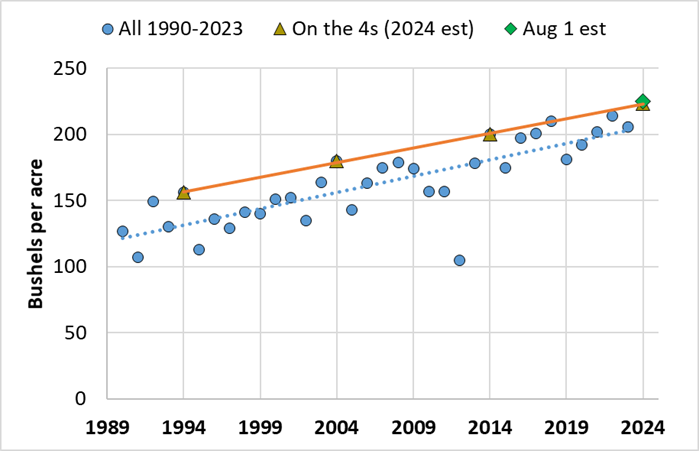Can Illinois Corn Yields Really Be That High?
Wet weather delayed planting of some of the 2024 Illinois corn crop, but stands (except in drowned-out low spots) are generally good. Warm, dry weather in June caused some water stress in places, but kept development moving and helped roots to establish. July-August rainfall totals have been above normal for almost the entire state, while temperatures have been normal to a little below normal.
Reflecting the favorable weather this growing season, the August 1 estimate of yields, released by the USDA (NASS) on August 12, projected the 2024 Illinois corn yield to be an astonishing 225 bushels per acre.
I noticed some years ago that in each of the last three years that end with 4 – 1994, 2004, and 2014 – Illinois corn yields reached a new record high. Each of these record yields exceeded the one from the decade before by about 22 bushels per acre. This pattern didn’t follow the script in the 1980s – the 1985 (not 1984) Illinois corn averaged 135 bushels per acre, a new record that would have fit on the same “on the 4s” line as the record yields from the next three decades.
Early in 2024, in an exercise that I thought would illustrate the folly of making projections with such numbers, I graphed Illinois corn yields over the years from 1990 through 2023, and ran a separate line through annual yields and also through the three record-high “on the 4s” yields, to project what yield might be in 2024. Figure 1 below shows the results, along with the August 1 yield estimate for 2024.

The August 1 estimate for 2024 (225 bu/ac) is actually 1.9 bushels higher than the yield projected for 2024 (223.1 bu/ac) by the line that runs through the “on the 4s” yields in 1994, 2004, and 2014. The 1990-2023 (dotted blue) line has a slope of 2.48 bushels per acre per year, and the “on the 4s” slope (not including 2024) is 2.21 bushels per acre per year. The 1990-2023 trendline projects a yield of 206 bushels per acre for 2024; the August 1 estimate is 19 bushels above trendline. It was rare that yield in any year that didn’t end in 4 came close to the “on the 4s” line, but this happened in 2018, with 210 bushels per acre.
We’ll have to wait to see if Illinois corn yield in 2024 actually reaches the August 1 estimate, but all signs at present – the high crop rating, continuing good weather, and the fact that the early-planted crop is nearing maturity – are positive. If the final number is 225, then including 2024 in the “on the 4s” line increases the slope of this line to 2.27 bushels per acre per year; this would project a yield of 247 bushels per acre in 2034. It might seem foolish to project such a yield ten years from now, but most of us would have thought the same thing about projecting the 2024 yield ten years ago.
Having record-high yields in years ending in 4 over four decades is not proof that this trend will continue, of course, but we can think of such years, whenever they occur, as ones in which favorable weather across most of the state allows the crop to yield closer to its genetic potential than it does in other years. As Figure 1 shows, the yield trend based on all years and the one based only on the “most favorable” years are converging. Leaving out the 2012 yield (105 bu/acre due to drought) and including the 2024 yield of 225 bu/acre increases the slope of the “all years” trendline to 2.67 bu/ac/yr, and including the 2024 yield increases the slope of the “on the 4s” trendline slightly, to 2.27 bu/ac/yr; the difference (0.4 bushels per acre per year) is the rate at which the lines converge. If these lines keep converging at that rate, the trendline yield based on all years would equal the “best-year” trendline yield by 2056. At that point, the average Illinois yield would be 297 bushels per acre. It may well be that these trends will decline before that, but we have no evidence to indicate that they will.
The US corn yield predicted for 2024 is also record-high, at 183.1 bushels per acre compared to the previous high of 176.7 (in 2021). Some have suggested that US yield increases may be slowing, though that appears more related to above-trendline yields from 2016 to 2018 than to a gradual slowdown. The US trendline over the past 30 years is increasing at about 1.86 bushels per acre per year, a rate about 30% lower than the trend in Illinois. Much of this difference stems from the fact that most places where corn is grown in the United States have soils and weather less conducive to high yields than those in Illinois. Yields everywhere benefit greatly from improvement in genetics, but it still takes good weather and good soil conditions, along with sound management, to translate genetics to yield.





